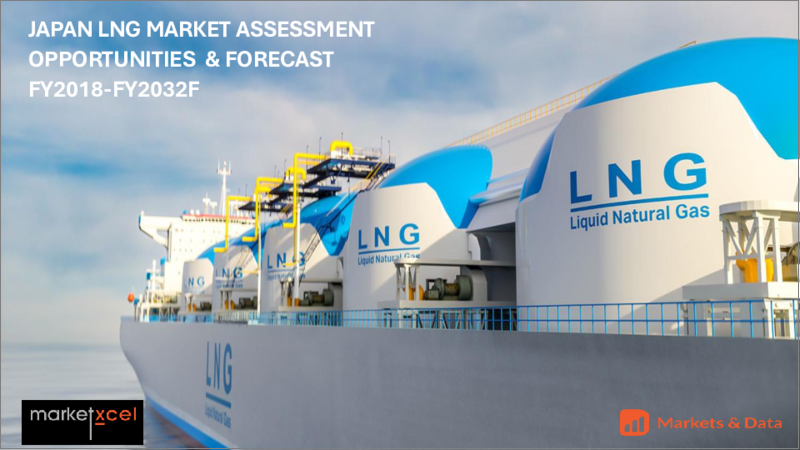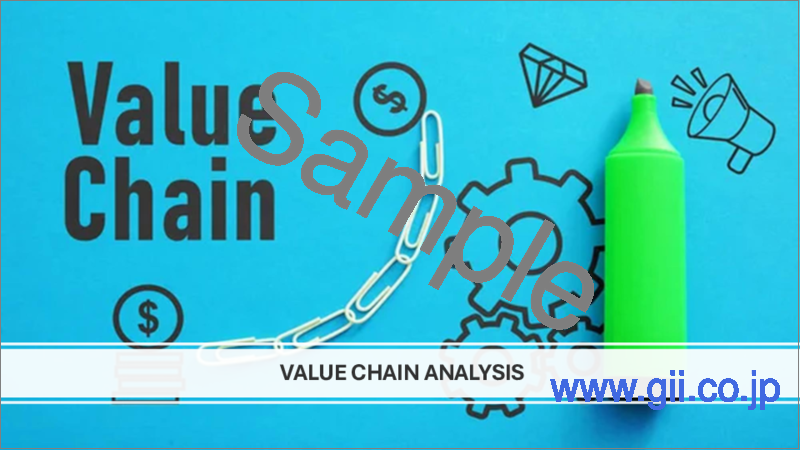|
|
市場調査レポート
商品コード
1566338
LNGの日本市場の評価:インフラ別、最終用途別、地域別、機会、予測(2018年度~2032年度)Japan LNG Market Assessment, By Infrastructure [LNG Liquefaction Plants, LNG Regasification Facilities, LNG Shipping], By End-use [Power Generation, Industrial, Residential and Commercial, Others], By Region, Opportunities and Forecast, FY2018-FY2032F |
||||||
カスタマイズ可能
|
|||||||
| LNGの日本市場の評価:インフラ別、最終用途別、地域別、機会、予測(2018年度~2032年度) |
|
出版日: 2024年10月09日
発行: Markets & Data
ページ情報: 英文 134 Pages
納期: 3~5営業日
|
全表示
- 概要
- 図表
- 目次
日本のLNGの市場規模は、2024年度の458億1,000万米ドルから2032年度に632億3,000万米ドルに達すると予測され、2025年度~2032年度の予測期間にCAGRで4.11%の成長が見込まれます。日本は世界最大のLNG輸入国の1つと見なされています。日本のエネルギー資源は限られているため、日本におけるLNG供給のニーズは高まっています。さらに、温室効果ガスの排出を削減することで、信頼性が高く合理的にクリーンなエネルギー源を確保する必要性から、LNGは日本のエネルギー情勢に欠かせない要素となっています。したがって、環境責任と経済成長の間で完璧なバランスが保たれています。
例えば、財務省の速報値によると、2024年5月の日本のLNG輸入は487万トンで、前年同月比5.6%の急増となっています。輸入コストは約28億5,000万米ドルで、前年同月比9.1%増となっています。こうした傾向は、予測不可能な世界の供給力学に直面する中、エネルギー需要を満たすために日本がLNGに依存し続けていることを浮き彫りにしました。
当レポートでは、日本のLNG市場について調査分析し、市場規模と予測、市場力学、主要企業の情勢などを提供しています。
目次
第1章 プロジェクトの範囲と定義
第2章 調査手法
第3章 エグゼクティブサマリー
第4章 顧客の声
- 製品と市場情報
- 購入決定において考慮される要素
- 発熱量
- 契約条件
- リードタイム
- 注文数量
- 安全対策
- インフラの処理能力
- サプライチェーンマネジメント
- 需給のメカニズム
- 購入チャネル
第5章 日本のLNG市場の見通し(2018年度~2032年度)
- 市場規模の分析と予測
- 金額
- 数量
- 市場シェアの分析と予測
- インフラ別
- 最終用途別
- 地域別
- 市場シェア分析:企業別(金額)(上位5社とその他 - 2024年度)
- 市場マップ分析(2024年度)
- インフラ別
- 最終用途別
- 地域別
第6章 需給分析
第7章 輸入と輸出の分析
第8章 バリューチェーン分析
第9章 ポーターのファイブフォース分析
第10章 PESTLE分析
第11章 価格分析
第12章 市場力学
- 市場促進要因
- 市場の課題
第13章 市場の動向と発展
第14章 ケーススタディ
第15章 競合情勢
- マーケットリーダー上位5社の競合マトリクス
- 上位5社のSWOT分析
- 上位8社の市場企業の主要企業の情勢
- Inpex Corporation
- Japan Petroleum Exploration Company Limited (JAPEX)
- Tokyo Gas Engineering Solutions Corporation
- Osaka Gas Co., Ltd.
- Toho Gas Co., Ltd.
- Saibu Gas Co. Ltd.
- The Kansai Electric Power Co., Inc.
- JERA Co., Inc.
第16章 戦略的推奨
第17章 当社について、免責事項
List of Tables
- Table 1. Pricing Analysis of Products from Key Players
- Table 2. Competition Matrix of Top 5 Market Leaders
- Table 3. Mergers & Acquisitions/ Joint Ventures (If Applicable)
- Table 4. About Us - Regions and Countries Where We Have Executed Client Projects
List of Figures
- Figure 1. Japan LNG Market, By Value, In USD Billion, FY2018-FY2032F
- Figure 2. Japan LNG Market, By Volume, In Million Tons, FY2018-FY2032F
- Figure 3. Japan LNG Market Share (%), By Infrastructure, FY2018-FY2032F
- Figure 4. Japan LNG Market Share (%), By End-use, FY2018-FY2032F
- Figure 5. Japan LNG Market Share (%), By Region, FY2018-FY2032F
- Figure 6. By Infrastructure Map-Market Size (USD Billion) & Growth Rate (%), FY2024
- Figure 7. By End-use Map-Market Size (USD Billion) & Growth Rate (%), FY2024
- Figure 8. By Region Map-Market Size (USD Billion) & Growth Rate (%), FY2024
Japan LNG market is expected to observe a CAGR of 4.11% during the forecast period FY2025- FY2032, rising from USD 45.81 billion in FY2024 to USD 63.23 billion in FY2032. Japan is regarded as one of the world's largest LNG importers. The need for LNG supply in Japan is increasing due to the country's limited local energy resources. Moreover, the necessity for reliable and reasonably clean energy sources by reducing greenhouse gas emissions makes LNG a vital component of the country's energy landscape. Hence, a perfect balance is maintained between environmental responsibility and economic growth.
For instance, in May 2024, Japan's LNG imports were 4.87 million tons, resulting in a surge of 5.6% from the same month last year, according to preliminary figures from Japan's finance ministry. The cost of the imports was roughly USD 2.85 billion, representing a 9.1% increase year-on-year. These patterns highlighted Japan's continued reliance on LNG to fulfill its energy demands in the face of unpredictable global supply dynamics.
Rise in Investments for LNG is Expediting Market Growth
With the growing need for secure energy supplies, Japan is actively investing in LNG. The Japanese government has intended to keep LNG handling capacity at around 100 million tons per year by 2030. Furthermore, Japanese corporations are extending investments in LNG facilities across Asia-Pacific with the aim of increasing energy security, thereby ensuring that they remain competitive in the rapidly changing global market.
For instance, in May 2024, Japan's JERA Co, Inc. intended to invest over USD 32 billion over the next decade in LNG and novel fuels, including hydrogen and ammonia. By FY2035, the corporation expects to handle approximately 35 million tons of LNG per year, 20 Gigawatts of renewable energy capacity, and 7 million tons of hydrogen and ammonia. The investment approach aligns with Japan's aim of lowering carbon emissions by at least 60% by FY2050, therefore promoting the transition to a low-carbon society.
Collaboration With Foreign Countries for Long-Term LNG Supplies is Expediting the Market Growth
Japan's cooperation with other nations on long-term LNG supply is essential for energy security and stability. Japan is diversifying its supply chain by boosting connections with different allies. The strategy mitigates geopolitical risks and ensures consistent LNG supplies to fulfill Japan's energy demands, especially as the country moves to a more environmentally friendly energy mix.
For instance, in May 2024, Japan boosted its reliance on Australia and the United States for long-term LNG supply by signing crucial contracts till the early 2030s. In response to uncertainty in Australian LNG supply policy, Japan is diversifying its sources by boosting connections with its allies. Recent equity investments in Australian and the United States projects aim to provide steady, long-term LNG supply, showing Japan's dedication to energy security in the face of changing global dynamics and the constant need for reliable energy sources.
Establishment of Regasification Facilities is Proliferating Market Growth
Japan has built a strong network of gasification plants to support significant usage of LNG. Japan is a leader in Asia-Pacific in terms of operational capabilities. The country has multiple LNG storage terminals, which together contribute a major share of Asia's total regasification capacity. The plants receive LNG from overseas, store it, and convert it back into gas for distribution through pipelines. The continued development of the terminals is crucial to ensure a clean and stable LNG supply in Japan's energy landscape.
For instance, in April 2024, Japan's Mitsui O.S.K. Lines Ltd. (MOL) started commercial operations of its floating storage & regasification unit (FSRU) to provide LNG to the Jawa 1 LNG-fired power plant. The FSRU, owned by MOL, has a total generating capacity of 1,760 MW, can store 170,000 m3 of LNG, and regasify 300 million standard cubic feet per day (MMcsfd).
Government Initiatives are Amplifying Market Prosperity
Government policies in Japan LNG market are critical for energy security and addressing future supply concerns. Investments in infrastructure and strategic alliances with nations such as Australia and the United States are crucial for sustaining a steady LNG supply. The initiatives are anticipated to cater to ample benefits for market expedition over the forecast years.
For instance, in March 2024, the Japanese government stated that it is actively shifting its focus on LNG in Southeast Asia. Japanese firms are investing in the LNG infrastructure of Vietnam, Philippines, and Indonesia to boost demand and expand trading capacity. The approach seeks to sustain Japan's yearly LNG handling capacity despite the rising LNG surpluses.
Central Japan is Leading the Market Share
Central Japan has emerged as a leader in the market due to its strategic infrastructure and significant consumption. The region has several important LNG terminals which facilitate LNG import and regasification to meet the energy needs of densely populated areas. Major utilities in central Japan, such as Jera Co Inc. and Tokyo Gas Co., Ltd., have historically been the largest buyers of LNG. The regions are recognized for their capability to secure long-term contracts for LNG projects.
Central Japan has one of the most prominent LNG companies in the country, Tokyo Gas Ltd. As per the Japanese government, Central Japan is shifting its focus to southeastern Asia for LNG trading. In August 2024, Tokyo Gas Ltd. collaborated with Mitsui Corporation to develop a 1,500 MW LNG power plant in Northern Vietnam. Moreover, Tokyo Gas Ltd. is preparing to develop an LNG terminal in Philippines, but it is still pending government approval.
Future Market Scenario (FY2025 - FY2032)
Japanese corporations are diversifying the LNG supplies and investing in LNG infrastructure for growing Asian regions to meet the demand adequately, which can prove to be a significant movement in the future for market proliferation.
The Japanese governments is making significant investments in LNG-fired power stations to strengthen its foothold in the Asian market, which is anticipated to yield significant benefits for market growth.
Japan's long-term energy policy is continuing to develop, balancing LNG dependency with the expansion of renewable and nuclear energy. Japanese utilities are improving their trading capabilities to properly handle surplus LNG and expand into new markets, thereby paving a great future for market growth.
Key Players Landscape and Outlook
Japanese companies have continued to invest in the building of LNG plants by aggressively making strategic investments. The Japanese companies have started developing LNG projects through various strategic partnerships. In such collaborative work, Japanese companies are planning to diversify risks, gain access to advanced technologies, and strengthen their positions in the frequently changing LNG market.
In December 2023, the Kansai Electric Power Group and Hartree Partners signed a contract to combine LNG supply with carbon investments. The partnership would further strengthen energy security while considering Japan's sustainability commitments. The deal fits well within the strategy of the Japanese government of balancing energy needs with decarbonization goals, thereby signifying a carbon-neutral LNG use. This reflects a growing trend in Japanese companies to embrace carbon management as a part of the energy supply chain and bring changes toward more sustainable energy practices.
Table of Contents
1. Project Scope and Definitions
2. Research Methodology
3. Executive Summary
4. Voice of Customer
- 4.1. Product and Market Intelligence
- 4.2. Factors Considered in Purchase Decisions
- 4.2.1. Calorific Value
- 4.2.2. Contract Terms
- 4.2.3. Lead Time
- 4.2.4. Order Quantity
- 4.2.5. Safety Measures
- 4.2.6. Infrastructure Capability
- 4.3. Supply Chain Management
- 4.4. Demand and Supply Mechanism
- 4.5. Channel of Purchase
5. Japan LNG Market Outlook, FY2018-FY2032F
- 5.1. Market Size Analysis & Forecast
- 5.1.1. By Value
- 5.1.2. By Volume
- 5.2. Market Share Analysis & Forecast
- 5.2.1. By Infrastructure
- 5.2.1.1. LNG Liquefaction Plants
- 5.2.1.2. LNG Regasification Facilities
- 5.2.1.3. LNG Shipping
- 5.2.2. By End-use
- 5.2.2.1. Power Generation
- 5.2.2.2. Industrial
- 5.2.2.3. Residential and Commercial
- 5.2.2.4. Others
- 5.2.3. By Region
- 5.2.3.1. North [Hokkaido and Tohoku]
- 5.2.3.2. Central [Kanto and Chubu]
- 5.2.3.3. South [Kansai, Chugoku, Shikoku, Kyushu, Okinawa]
- 5.2.4. By Company Market Share Analysis (Top 5 Companies and Others - By Value, FY2024)
- 5.2.1. By Infrastructure
- 5.3. Market Map Analysis, FY2024
- 5.3.1. By Infrastructure
- 5.3.2. By End-use
- 5.3.3. By Region
6. Demand Supply Analysis
7. Import and Export Analysis
8. Value Chain Analysis
9. Porter's Five Forces Analysis
10. PESTLE Analysis
11. Pricing Analysis
12. Market Dynamics
- 12.1. Market Drivers
- 12.2. Market Challenges
13. Market Trends and Developments
14. Case Studies
15. Competitive Landscape
- 15.1. Competition Matrix of Top 5 Market Leaders
- 15.2. SWOT Analysis for Top 5 Players
- 15.3. Key Players Landscape for Top 8 Market Players
- 15.3.1. Inpex Corporation
- 15.3.1.1. Company Details
- 15.3.1.2. Key Management Personnel
- 15.3.1.3. Products and Services
- 15.3.1.4. Financials (As Reported)
- 15.3.1.5. Key Market Focus and Geographical Presence
- 15.3.1.6. Recent Developments/Collaborations/Partnerships/Mergers and Acquisition
- 15.3.2. Japan Petroleum Exploration Company Limited (JAPEX)
- 15.3.3. Tokyo Gas Engineering Solutions Corporation
- 15.3.4. Osaka Gas Co., Ltd.
- 15.3.5. Toho Gas Co., Ltd.
- 15.3.6. Saibu Gas Co. Ltd.
- 15.3.7. The Kansai Electric Power Co., Inc.
- 15.3.8. JERA Co., Inc.
- 15.3.1. Inpex Corporation
Companies mentioned above DO NOT hold any order as per market share and can be changed as per information available during research work.






